Attached files
| file | filename |
|---|---|
| 8-K - FORM 8-K - FEDERAL NATIONAL MORTGAGE ASSOCIATION FANNIE MAE | w76148e8vk.htm |
| EX-99.1 - EX-99.1 - FEDERAL NATIONAL MORTGAGE ASSOCIATION FANNIE MAE | w76148exv99w1.htm |
Exhibit 99.2
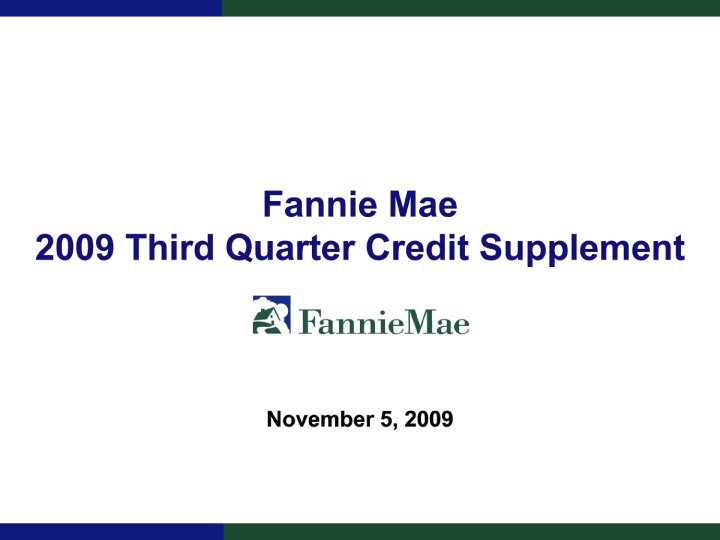
| Exhibit 99.2 Fannie Mae 2009 Third Quarter Credit Supplement November 5, 2009 |
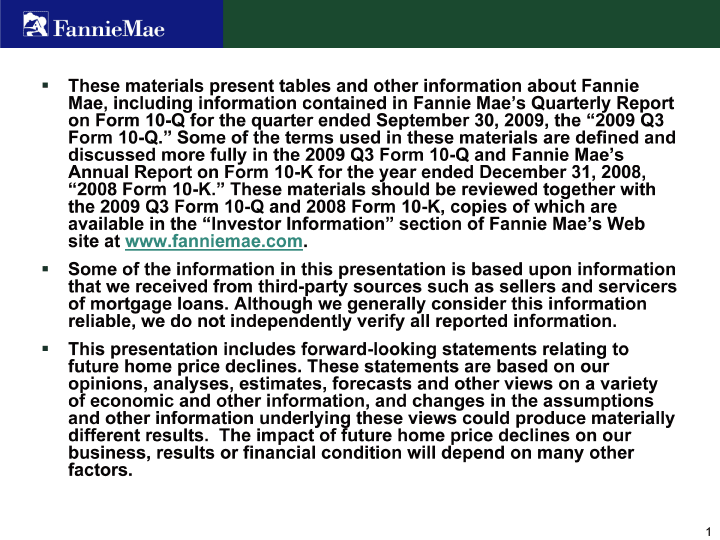
| These materials present tables and other information about Fannie Mae, including information contained in Fannie Mae’s Quarterly Report on Form 10-Q for the quarter ended September 30, 2009, the “2009 Q3 Form 10-Q.” Some of the terms used in these materials are defined and discussed more fully in the 2009 Q3 Form 10-Q and Fannie Mae’s Annual Report on Form 10-K for the year ended December 31, 2008, “2008 Form 10-K.” These materials should be reviewed together with the 2009 Q3 Form 10-Q and 2008 Form 10-K, copies of which are available in the “Investor Information” section of Fannie Mae’s Web site at www.fanniemae.com. Some of the information in this presentation is based upon information that we received from third-party sources such as sellers and servicers of mortgage loans. Although we generally consider this information reliable, we do not independently verify all reported information. This presentation includes forward-looking statements relating to future home price declines. These statements are based on our opinions, analyses, estimates, forecasts and other views on a variety of economic and other information, and changes in the assumptions and other information underlying these views could produce materially different results. The impact of future home price declines on our business, results or financial condition will depend on many other factors. |
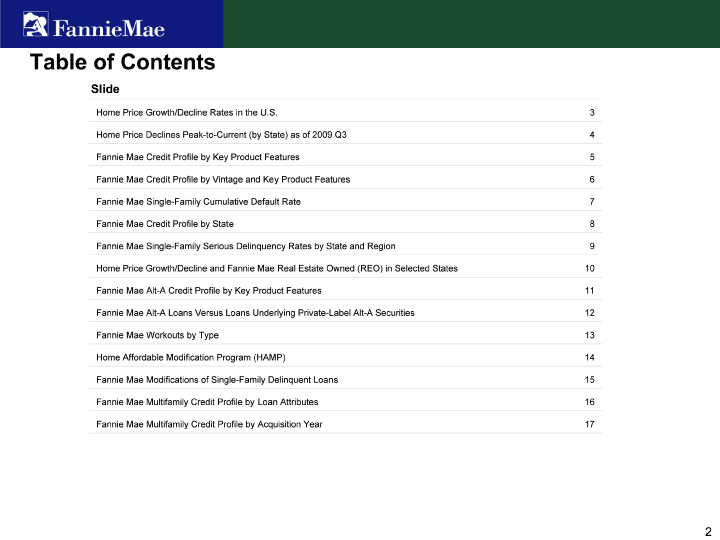
| Table of Contents Slide Home Price Growth/Decline Rates in the U.S. 3 Home Price Declines Peak-to-Current (by State) as of 2009 Q3 4 Fannie Mae Credit Profile by Key Product Features 5 Fannie Mae Credit Profile by Vintage and Key Product Features 6 Fannie Mae Single-Family Cumulative Default Rate 7 Fannie Mae Credit Profile by State 8 Fannie Mae Single-Family Serious Delinquency Rates by State and Region 9 Home Price Growth/Decline and Fannie Mae Real Estate Owned (REO) in Selected States 10 Fannie Mae Alt-A Credit Profile by Key Product Features 11 Fannie Mae Alt-A Loans Versus Loans Underlying Private-Label Alt-A Securities 12 Fannie Mae Workouts by Type 13 Home Affordable Modification Program (HAMP) 14 Fannie Mae Modifications of Single-Family Delinquent Loans 15 Fannie Mae Multifamily Credit Profile by Loan Attributes 16 Fannie Mae Multifamily Credit Profile by Acquisition Year 17 |
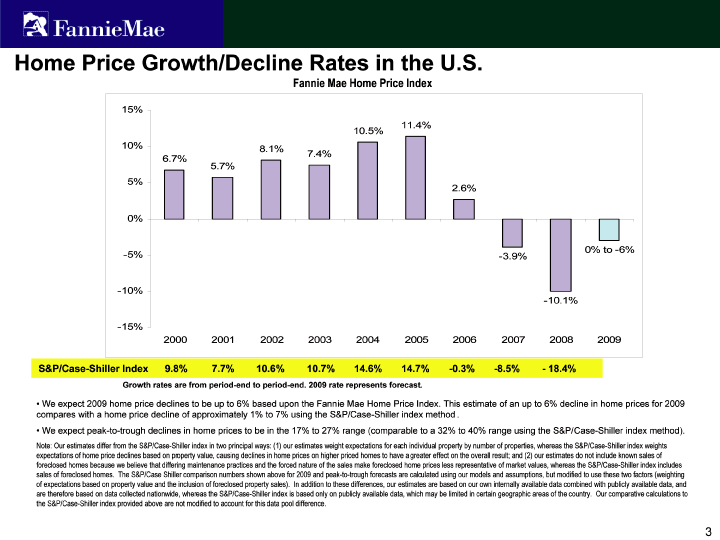
| Home Price Growth/Decline Rates in the U.S Fannie Mae Home Price Index S&P/Case-Shiller Index 9.8% 7.7% 10.6% 10.7% 14.6% 14.7% -0.3% -8.5% — 18.4% Growth rates are from period-end to period-end. 2009 rate represents forecast. · We expect 2009 home price declines to be up to 6% based upon the Fannie Mae Home Price Index. This estimate of an up to 6% decline in home prices for 2009 compares with a home price decline of approximately 1% to 7% using the S&P/Case-Shiller index method. · We expect peak-to-trough declines in home prices to be in the 17% to 27% range (comparable to a 32% to 40% range using the S&P/Case-Shiller index method). Note: Our estimates differ from the S&P/Case-Shiller index in two principal ways: (1) our estimates weight expectations for each individual property by number of properties, whereas the S&P/Case-Shiller index weights expectations of home price declines based on property value, causing declines in home prices on higher priced homes to have a greater effect on the overall result; and (2) our estimates do not include known sales of foreclosed homes because we believe that differing maintenance practices and the forced nature of the sales make foreclosed home prices less representative of market values, whereas the S&P/Case-Shiller index includes sales of foreclosed homes. The S&P/Case Shiller comparison numbers shown above for 2009 and peak-to-trough forecasts are calculated using our models and assumptions, but modified to use these two factors (weighting of expectations based on property value and the inclusion of foreclosed property sales). In addition to these differences, our estimates are based on our own internally available data combined with publicly available data, and are therefore based on data collected nationwide, whereas the S&P/Case-Shiller index is based only on publicly available data, which may be limited in certain geographic areas of the country. Our comparative calculations to the S&P/Case-Shiller index provided above are not modified to account for this data pool difference. |
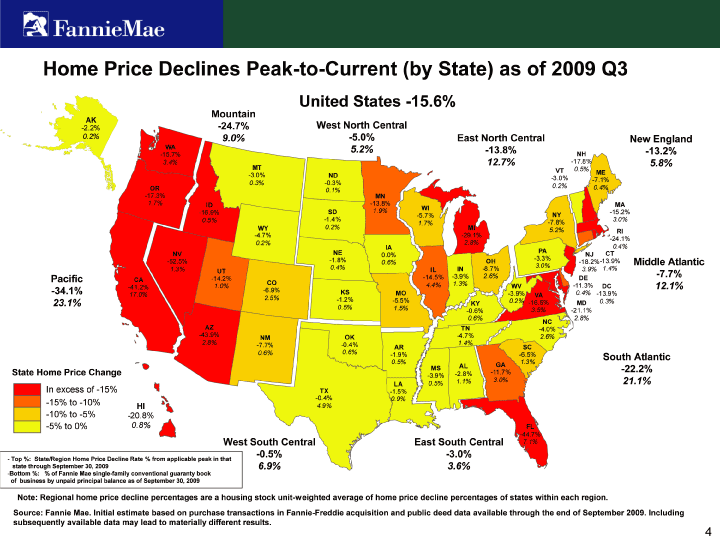
| Home Price Declines Peak-to-Current (by State) as of 2009 Q3 United States -15.6% Mountain AK -2.2% -24.7% West North Central 0.2% 9.0% -5.0% East North Central New England WA 5.2% -13.8% -13.2% -15.7% NH 3.4% 12.7% -17.8% 5.8% MT 0.5% VT ME -3.0% ND -3.0% -7.1% 0.3% -0.3% OR 0.2% 0.4% 0.1% -17.3% MN 1.7% ID -13.8% MA 1.9% WI -16.9% SD -15.2% -5.7% NY 0.5% -1.4% 3.0% 1.7% -7.8% WY 0.2% MI 5.2% RI -4.7% -29.1% -24.1% 0.2% 2.8% IA 0.4% NE PA CT NV 0.0% NJ -1.8% -3.3% -13.9% -52.5% 0.6% OH -18.2% Middle Atlantic 0.4% 3.0% 1.4% 1.3% UT IL IN -8.7% 3.9% -14.5% -3.9% 2.6% -7.7% Pacific CA -14.2% DE CO 4.4% 1.3% -11.3% -41.2% 1.0% WV DC 12.1% -34.1% -6.9% KS 0.4% 17.0% MO -3.9% VA -13.9% 2.5% -1.2% -5.5% 23.1% KY 0.2% -16.5% MD 0.3% 0.5% 1.5% 3.5% -0.6% -21.1% 0.6% 2.8% NC AZ TN -4.0% -43.9% OK -4.7% 2.6% NM 2.8% -7.7% -0.4% 1.4% AR SC 0.6% 0.6% -1.9% -6.5% South Atlantic 0.5% 1.3% AL GA MS -22.2% State Home Price Change -2.8% -11.7% -3.9% 1.1% 3.0% 21.1% LA 0.5% In excess of -15% TX -1.5% -0.4% 0.9% -15% to -10% HI 4.9% -10% to -5% -20.8% -5% to 0% 0.8% FL -44.7% West South Central East South Central 7.1% -0.5% -3.0% — Top %: State/Region Home Price Decline Rate % from applicable peak in that state through September 30, 2009 6.9% 3.6% -Bottom %: % of Fannie Mae single-family conventional guaranty book of business by unpaid principal balance as of September 30, 2009 Note: Regional home price decline percentages are a housing stock unit-weighted average of home price decline percentages of states within each region. Source: Fannie Mae. Initial estimate based on purchase transactions in Fannie-Freddie acquisition and public deed data available through the end of September 2009. Including subsequently available data may lead to materially different results. |
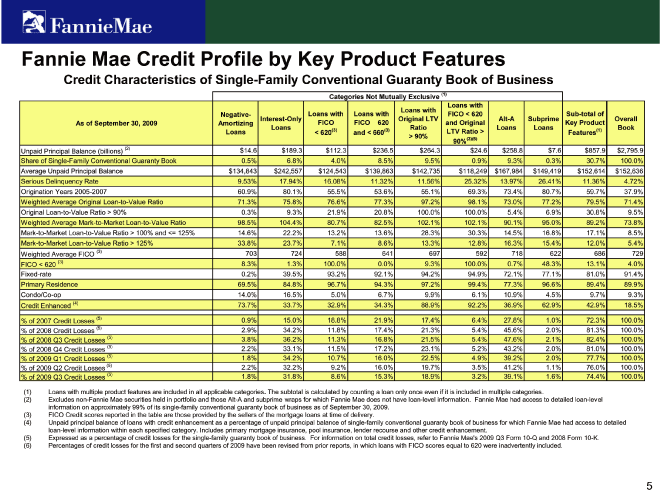
| Fannie Mae Credit Profile by Key Product Features Credit Characteristics of Single-Family Conventional Guaranty Book of Business Categories Not Mutually Exclusive (1) Loans with Loans with Negative- Loans with Loans with FICO < 620 Sub-total of Interest-Only Original LTV Alt-A Subprime Overall As of September 30, 2009 Amortizing FICO = 620 and Original Key Product Loans Ratio Loans Loans Book (3) and < 660(3) LTV Ratio > Features(1) 90% (3)(6) Unpaid Principal Balance (billions) (2) $ 14.6 $ 189.3 $ 112.3 $ 236.5 $ 264.3 $ 24.6 $ 258.8 $ 7.6 $ 857.9 $2,795.9 |
| Share of Single-Family Conventional Guaranty Book 0.5% 6.8% 4.0% 8.5% 9.5% 0.9% 9.3% 0.3% 30.7% 100.0% Average Unpaid Principal Balance $134,843 $242,557 $124,543 $139,863 $142,735 $ 118,249 $167,984 $149,419 $152,614 $152,636 Serious Delinquency Rate 9.53% 17.94% 16.08% 11.32% 11.56% 25.32% 13.97% 26.41% 11.36% 4.72% Origination Years 2005-2007 60.9% 80.1% 55.5% 53.6% 55.1% 69.3% 73.4% 80.7% 59.7% 37.9% Weighted Average Original Loan-to-Value Ratio 71.3% 75.8% 76.6% 77.3% 97.2% 98.1% 73.0% 77.2% 79.5% 71.4% Original Loan-to-Value Ratio > 90% 0.3% 9.3% 21.9% 20.8% 100.0% 100.0% 5.4% 6.9% 30.8% 9.5% Weighted Average Mark-to-Market Loan-to-Value Ratio 98.5% 104.4% 80.7% 82.5% 102.1% 102.1% 90.1% 95.0% 89.2% 73.8% Mark-to-Market Loan-to-Value Ratio > 100% and <= 125% 14.6% 22.2% 13.2% 13.6% 28.3% 30.3% 14.5% 16.8% 17.1% 8.5% Mark-to-Market Loan-to-Value Ratio > 125% 33.8% 23.7% 7.1% 8.6% 13.3% 12.8% 16.3% 15.4% 12.0% 5.4% Weighted Average FICO (3) 703 724 588 641 697 592 718 622 686 729 FICO < 620 (3) 8.3% 1.3% 100.0% 0.0% 9.3% 100.0% 0.7% 48.3% 13.1% 4.0% Fixed-rate 0.2% 39.5% 93.2% 92.1% 94.2% 94.9% 72.1% 77.1% 81.0% 91.4% Primary Residence 69.5% 84.8% 96.7% 94.3% 97.2% 99.4% 77.3% 96.6% 89.4% 89.9% Condo/Co-op 14.0% 16.5% 5.0% 6.7% 9.9% 6.1% 10.9% 4.5% 9.7% 9.3% Credit Enhanced (4) 73.7% 33.7% 32.9% 34.3% 88.9% 92.2% 36.9% 62.9% 42.9% 18.5% % of 2007 Credit Losses (5) 0.9% 15.0% 18.8% 21.9% 17.4% 6.4% 27.8% 1.0% 72.3% 100.0% % of 2008 Credit Losses (5) 2.9% 34.2% 11.8% 17.4% 21.3% 5.4% 45.6% 2.0% 81.3% 100.0% % of 2008 Q3 Credit Losses (5) 3.8% 36.2% 11.3% 16.8% 21.5% 5.4% 47.6% 2.1% 82.4% 100.0% % of 2008 Q4 Credit Losses (5) 2.2% 33.1% 11.5% 17.2% 23.1% 5.2% 43.2% 2.0% 81.0% 100.0% % of 2009 Q1 Credit Losses (5) 1.8% 34.2% 10.7% 16.0% 22.5% 4.9% 39.2% 2.0% 77.7% 100.0% % of 2009 Q2 Credit Losses (5) 2.2% 32.2% 9.2% 16.0% 19.7% 3.5% 41.2% 1.1% 76.0% 100.0% % of 2009 Q3 Credit Losses (5) 1.8% 31.8% 8.6% 15.3% 18.9% 3.2% 39.1% 1.6% 74.4% 100.0% (1) Loans with multiple product features are included in all applicable categories. The subtotal is calculated by counting a loan only once even if it is included in multiple categories. (2) Excludes non-Fannie Mae securities held in portfolio and those Alt-A and subprime wraps for which Fannie Mae does not have loan-level information. Fannie Mae had access to detailed loan-level information on approximately 99% of its single-family conventional guaranty book of business as of September 30, 2009. (3) FICO Credit scores reported in the table are those provided by the sellers of the mortgage loans at time of delivery. (4) Unpaid principal balance of loans with credit enhancement as a percentage of unpaid principal balance of single-family conventional guaranty book of business for which Fannie Mae had access to detailed loan-level information within each specified category. Includes primary mortgage insurance, pool insurance, lender recourse and other credit enhancement. (5) Expressed as a percentage of credit losses for the single-family guaranty book of business. For information on total credit losses, refer to Fannie Mae’s 2009 Q3 Form 10-Q and 2008 Form 10-K. (6) Percentages of credit losses for the first and second quarters of 2009 have been revised from prior reports, in which loans with FICO scores equal to 620 were inadvertently included. |
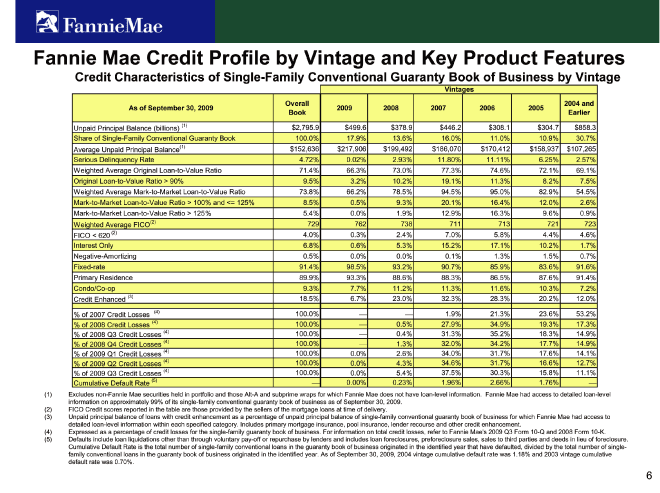
| Fannie Mae Credit Profile by Vintage and Key Product Features Credit Characteristics of Single-Family Conventional Guaranty Book of Business by Vintage Overall 2004 and As of September 30, 2009 Book Earlier |
| Unpaid Principal Balance (billions) (1) $2,795.9 $ 499.6 $ 378.9 $ 446.2 $ 308.1 $ 304.7 $ 858.3 Share of Single-Family Conventional Guaranty Book 100.0% 17.9% 13.6% 16.0% 11.0% 10.9% 30.7% Average Unpaid Principal Balance(1) $152,636 $217,906 $199,492 $186,070 $170,412 $158,937 $107,265 Serious Delinquency Rate 4.72% 0.02% 2.93% 11.80% 11.11% 6.25% 2.57% Weighted Average Original Loan-to-Value Ratio 71.4% 66.3% 73.0% 77.3% 74.6% 72.1% 69.1% Original Loan-to-Value Ratio > 90% 9.5% 3.2% 10.2% 19.1% 11.3% 8.2% 7.5% Weighted Average Mark-to-Market Loan-to-Value Ratio 73.8% 66.2% 78.5% 94.5% 95.0% 82.9% 54.5% Mark-to-Market Loan-to-Value Ratio > 100% and <= 125% 8.5% 0.5% 9.3% 20.1% 16.4% 12.0% 2.6% Mark-to-Market Loan-to-Value Ratio > 125% 5.4% 0.0% 1.9% 12.9% 16.3% 9.6% 0.9% Weighted Average FICO(2) 729 762 738 711 713 721 723 FICO < 620 (2) 4.0% 0.3% 2.4% 7.0% 5.8% 4.4% 4.6% Interest Only 6.8% 0.6% 5.3% 15.2% 17.1% 10.2% 1.7% Negative-Amortizing 0.5% 0.0% 0.0% 0.1% 1.3% 1.5% 0.7% Fixed-rate 91.4% 98.5% 93.2% 90.7% 85.9% 83.6% 91.6% Primary Residence 89.9% 93.3% 88.6% 88.3% 86.5% 87.6% 91.4% Condo/Co-op 9.3% 7.7% 11.2% 11.3% 11.6% 10.3% 7.2% Credit Enhanced (3) 18.5% 6.7% 23.0% 32.3% 28.3% 20.2% 12.0% % of 2007 Credit Losses (4) 100.0% 1.9% 21.3% 23.6% 53.2% % of 2008 Credit Losses (4) 100.0% 0.5% 27.9% 34.9% 19.3% 17.3% % of 2008 Q3 Credit Losses (4) 100.0% 0.4% 31.3% 35.2% 18.3% 14.9% % of 2008 Q4 Credit Losses (4) 100.0% 1.3% 32.0% 34.2% 17.7% 14.9% % of 2009 Q1 Credit Losses (4) 100.0% 0.0% 2.6% 34.0% 31.7% 17.6% 14.1% % of 2009 Q2 Credit Losses (4) 100.0% 0.0% 4.3% 34.6% 31.7% 16.6% 12.7% % of 2009 Q3 Credit Losses (4) 100.0% 0.0% 5.4% 37.5% 30.3% 15.8% 11.1% Cumulative Default Rate (5) 0.00% 0.23% 1.96% 2.66% 1.76% (1) Excludes non-Fannie Mae securities held in portfolio and those Alt-A and subprime wraps for which Fannie Mae does not have loan-level information. Fannie Mae had access to detailed loan-level information on approximately 99% of its single-family conventional guaranty book of business as of September 30, 2009. (2) FICO Credit scores reported in the table are those provided by the sellers of the mortgage loans at time of delivery. (3) Unpaid principal balance of loans with credit enhancement as a percentage of unpaid principal balance of single-family conventional guaranty book of business for which Fannie Mae had access to detailed loan-level information within each specified category. Includes primary mortgage insurance, pool insurance, lender recourse and other credit enhancement. (4) Expressed as a percentage of credit losses for the single-family guaranty book of business. For information on total credit losses, refer to Fannie Mae’s 2009 Q3 Form 10-Q and 2008 Form 10-K. (5) Defaults include loan liquidations other than through voluntary pay-off or repurchase by lenders and includes loan foreclosures, preforeclosure sales, sales to third parties and deeds in lieu of foreclosure. Cumulative Default Rate is the total number of single-family conventional loans in the guaranty book of business originated in the identified year that have defaulted, divided by the total number of single- family conventional loans in the guaranty book of business originated in the identified year. As of September 30, 2009, 2004 vintage cumulative default rate was 1.18% and 2003 vintage cumulative default rate was 0.70%. |
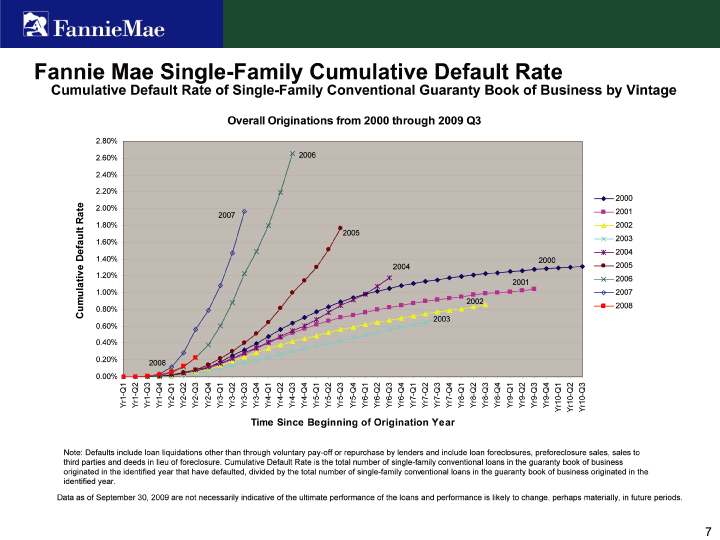
| Fannie Mae Single-Family Cumulative Default Rate Cumulative Default Rate of Single-Family Conventional Guaranty Book of Business by Vintage Overall Originations from 2000 through 2009 Q3 2.80% 2.60% 2006 2.40% 2.20% 2000 2.00% 2001 Rate 2007 1.80% 2002 Default 2005 2003 1.60% 2004 1.40% 2000 2004 2005 Cumulative 1.20% 2001 2006 1.00% 2007 2002 2008 0.80% 2003 0.60% 0.40% 0.20% 2008 0.00% Yr1-Q1 Yr1-Q2 Yr1-Q3 Yr1-Q4 Yr2-Q1 Yr2-Q2 Yr2-Q3 Yr2-Q4 Yr3-Q1 Yr3-Q2 Yr3-Q3 Yr3-Q4 Yr4-Q1 Yr4-Q2 Yr4-Q3 Yr4-Q4 Yr5-Q1 Yr5-Q2 Yr5-Q3 Yr5-Q4 Yr6-Q1 Yr6-Q2 Yr6-Q3 Yr6-Q4 Yr7-Q1 Yr7-Q2 Yr7-Q3 Yr7-Q4 Yr8-Q1 Yr8-Q2 Yr8-Q3 Yr8-Q4 Yr9-Q1 Yr9-Q2 Yr9-Q3 Yr9-Q4 Yr10-Q1 Yr10-Q2 Yr10-Q3 Time Since Beginning of Origination Year Note: Defaults include loan liquidations other than through voluntary pay-off or repurchase by lenders and include loan foreclosures, preforeclosure sales, sales to third parties and deeds in lieu of foreclosure. Cumulative Default Rate is the total number of single-family conventional loans in the guaranty book of business originated in the identified year that have defaulted, divided by the total number of single-family conventional loans in the guaranty book of business originated in the identified year. Data as of September 30, 2009 are not necessarily indicative of the ultimate performance of the loans and performance is likely to change, perhaps materially, in future periods. |
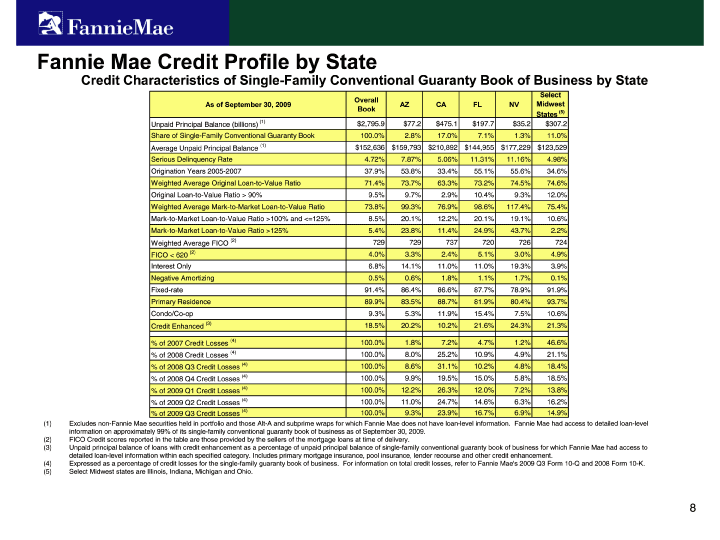
| Fannie Mae Credit Profile by State Credit Characteristics of Single-Family Conventional Guaranty Book of Business by State Select Overall As of September 30, 2009 AZ CA FL NV Midwest Book (5) States Unpaid Principal Balance (billions) (1) $2,795.9 $ 77.2 $ 475.1 $ 197.7 $ 35.2 $ 307.2 Share of Single-Family Conventional Guaranty Book 100.0% 2.8% 17.0% 7.1% 1.3% 11.0% Average Unpaid Principal Balance (1) $152,636 $159,793 $210,892 $144,955 $177,229 $123,529 Serious Delinquency Rate 4.72% 7.87% 5.06% 11.31% 11.16% 4.98% Origination Years 2005-2007 37.9% 53.8% 33.4% 55.1% 55.6% 34.6% Weighted Average Original Loan-to-Value Ratio 71.4% 73.7% 63.3% 73.2% 74.5% 74.6% Original Loan-to-Value Ratio > 90% 9.5% 9.7% 2.9% 10.4% 9.3% 12.0% Weighted Average Mark-to-Market Loan-to-Value Ratio 73.8% 99.3% 76.9% 98.6% 117.4% 75.4% Mark-to-Market Loan-to-Value Ratio >100% and <=125% 8.5% 20.1% 12.2% 20.1% 19.1% 10.6% Mark-to-Market Loan-to-Value Ratio >125% 5.4% 23.8% 11.4% 24.9% 43.7% 2.2% Weighted Average FICO (2) 729 729 737 720 726 724 |
| FICO < 620 (2) 4.0% 3.3% 2.4% 5.1% 3.0% 4.9%
Interest Only 6.8% 14.1% 11.0% 11.0% 19.3% 3.9%
Negative Amortizing 0.5% 0.6% 1.8% 1.1% 1.7% 0.1%
Fixed-rate 91.4% 86.4% 86.6% 87.7% 78.9% 91.9%
Primary Residence 89.9% 83.5% 88.7% 81.9% 80.4% 93.7%
Condo/Co-op 9.3% 5.3% 11.9% 15.4% 7.5% 10.6%
Credit Enhanced (3) 18.5% 20.2% 10.2% 21.6% 24.3% 21.3%
% of 2007 Credit Losses (4) 100.0% 1.8% 7.2% 4.7% 1.2% 46.6%
% of 2008 Credit Losses (4) 100.0% 8.0% 25.2% 10.9% 4.9% 21.1%
% of 2008 Q3 Credit Losses (4) 100.0% 8.6% 31.1% 10.2% 4.8% 18.4%
% of 2008 Q4 Credit Losses (4) 100.0% 9.9% 19.5% 15.0% 5.8% 18.5%
% of 2009 Q1 Credit Losses (4) 100.0% 12.2% 26.3% 12.0% 7.2% 13.8%
% of 2009 Q2 Credit Losses (4) 100.0% 11.0% 24.7% 14.6% 6.3% 16.2%
% of 2009 Q3 Credit Losses (4) 100.0% 9.3% 23.9% 16.7% 6.9% 14.9%
(1) Excludes non-Fannie Mae securities held in portfolio and those Alt-A and subprime wraps for
which Fannie Mae does not have loan-level information. Fannie Mae had access to detailed loan-level
information on approximately 99% of its single-family conventional guaranty book of business as of
September 30, 2009.
(2) FICO Credit scores reported in the table are those provided by the sellers of the mortgage
loans at time of delivery.
(3) Unpaid principal balance of loans with credit enhancement as a percentage of unpaid principal
balance of single-family conventional guaranty book of business for which Fannie Mae had access to
detailed loan-level information within each specified category. Includes primary mortgage
insurance, pool insurance, lender recourse and other credit enhancement. (4) Expressed as a percentage of credit losses for the single-family guaranty book of business. For information on total credit losses, refer to Fannie Mae’s 2009 Q3 Form 10-Q and 2008 Form 10-K. (5) Select Midwest states are Illinois, Indiana, Michigan and Ohio. |
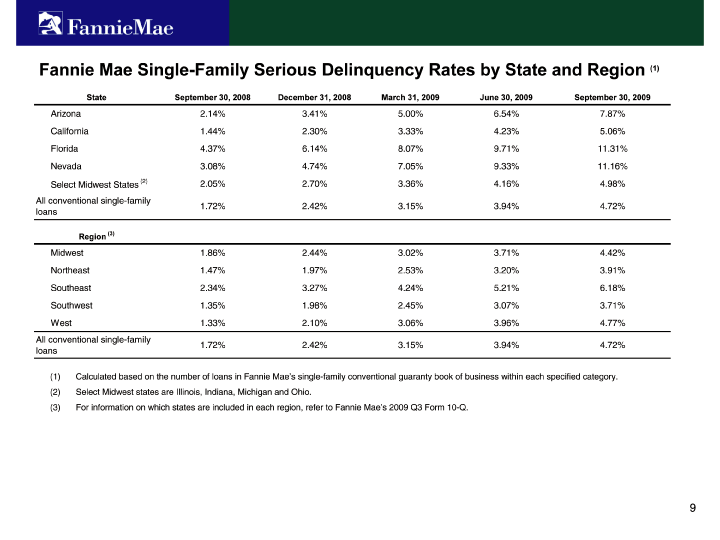
| Fannie Mae Single-Family Serious Delinquency Rates by State and Region (1) State September 30, 2008 December 31, 2008 March 31, 2009 June 30, 2009 September 30, 2009 |
| Arizona 2.14% 3.41% 5.00% 6.54% 7.87% California 1.44% 2.30% 3.33% 4.23% 5.06% Florida 4.37% 6.14% 8.07% 9.71% 11.31% Nevada 3.08% 4.74% 7.05% 9.33% 11.16% Select Midwest States (2) 2.05% 2.70% 3.36% 4.16% 4.98% All conventional single-family 1.72% 2.42% 3.15% 3.94% 4.72% loans Region (3) Midwest 1.86% 2.44% 3.02% 3.71% 4.42% Northeast 1.47% 1.97% 2.53% 3.20% 3.91% Southeast 2.34% 3.27% 4.24% 5.21% 6.18% Southwest 1.35% 1.98% 2.45% 3.07% 3.71% West 1.33% 2.10% 3.06% 3.96% 4.77% All conventional single-family 1.72% 2.42% 3.15% 3.94% 4.72% loans (1) Calculated based on the number of loans in Fannie Mae’s single-family conventional guaranty book of business within each specified category. (2) Select Midwest states are Illinois, Indiana, Michigan and Ohio. (3) For information on which states are included in each region, refer to Fannie Mae’s 2009 Q3 Form 10-Q. |

| Home Price Growth/Decline and Fannie Mae Real Estate Owned (REO) in Selected States 5-Year REO Acquisitions (Number of Properties) 1-Year HP REO REO Annualized HP Growth Inventory Inventory Growth October 2008 State as of as of October 2004 to 2007 2008 2009 Q1(1) 2009 Q2(1) 2009 Q3(1) September September to September 30, 2008 30, 2009 September 2009(2) 2009(2) Arizona 751 5,532 2,526 2,879 3,172 3,289 4,586 -18.0% -2.8% California 1,681 10,624 3,719 4,444 5,304 7,957 8,954 -12.3% -5.8% Florida 1,714 6,159 1,680 2,876 4,053 3,785 5,537 -15.3% -4.2% Nevada 530 2,906 1,210 1,337 1,885 1,902 2,659 -25.6% -10.3% Select Midwest States (3) 16,678 23,668 4,643 6,930 7,834 19,412 18,680 -4.8% -2.1% All other States 27,767 45,763 11,596 13,629 18,711 31,174 31,859 -3.0% 1.7% Total 49,121 94,652 25,374 32,095 40,959 67,519 72,275 -5.6% -0.2% (1) Fannie Mae’s REO acquisitions and REO reflect the impact of Fannie Mae’s foreclosure moratoriums in late 2008 and early 2009 and its directive to loan servicers to delay foreclosure sales until the servicers have exhausted foreclosure prevention alternatives. (2) Initial estimate based on purchase transactions in Fannie-Freddie acquisition and public deed data available through the end of September 2009. Including subsequently available data may lead to materially different results. (3) Select Midwest states are Illinois, Indiana, Michigan and Ohio. On a national basis, REO net sales prices compared with unpaid principal balances of mortgage loans were as follows, driving loss severities: 70% in 2008 Q3 61% in 2008 Q4 57% in 2009 Q1 54% in 2009 Q2 54% in 2009 Q3 |
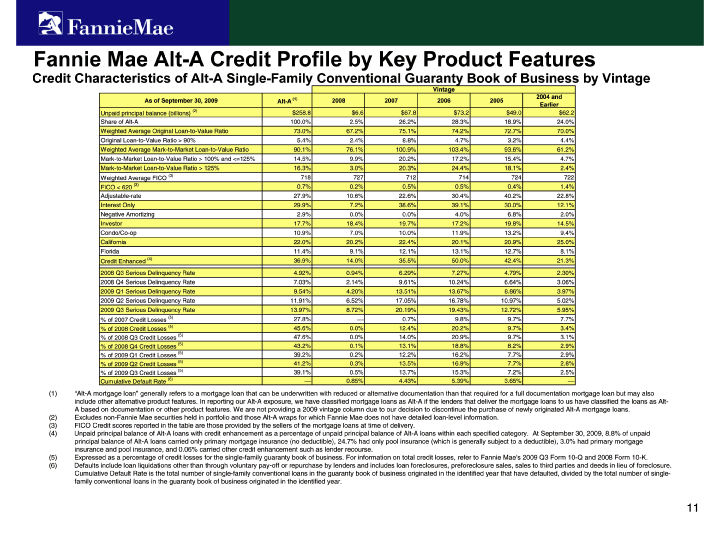
| Fannie Mae Alt-A Credit Profile by Key Product Features |
| Credit Characteristics of Alt-A Single-Family Conventional Guaranty Book of Business by Vintage (1) 2004 and As of September 30, 2009 Alt-A 2008 2007 2006 2005 Earlier Unpaid principal balance (billions) (2) $ 258.8 $ 6.6 $ 67.8 $ 73.2 $ 49.0 $ 62.2 Share of Alt-A 100.0% 2.5% 26.2% 28.3% 18.9% 24.0% Weighted Average Original Loan-to-Value Ratio 73.0% 67.2% 75.1% 74.2% 72.7% 70.0% Original Loan-to-Value Ratio > 90% 5.4% 2.4% 8.8% 4.7% 3.2% 4.4% Weighted Average Mark-to-Market Loan-to-Value Ratio 90.1% 76.1% 100.9% 103.4% 93.6% 61.2% Mark-to-Market Loan-to-Value Ratio > 100% and <=125% 14.5% 9.9% 20.2% 17.2% 15.4% 4.7% Mark-to-Market Loan-to-Value Ratio > 125% 16.3% 3.0% 20.3% 24.4% 18.1% 2.4% Weighted Average FICO (3) 718 727 712 714 724 722 FICO < 620 (3) 0.7% 0.2% 0.5% 0.5% 0.4% 1.4% Adjustable-rate 27.9% 10.6% 22.6% 30.4% 40.2% 22.8% Interest Only 29.9% 7.2% 38.6% 39.1% 30.0% 12.1% Negative Amortizing 2.9% 0.0% 0.0% 4.0% 6.8% 2.0% Investor 17.7% 18.4% 19.7% 17.2% 19.8% 14.5% Condo/Co-op 10.9% 7.0% 10.0% 11.9% 13.2% 9.4% California 22.0% 20.2% 22.4% 20.1% 20.9% 25.0% Florida 11.4% 9.1% 12.1% 13.1% 12.7% 8.1% Credit Enhanced (4) 36.9% 14.0% 35.5% 50.0% 42.4% 21.3% 2008 Q3 Serious Delinquency Rate 4.92% 0.94% 6.29% 7.27% 4.79% 2.30% 2008 Q4 Serious Delinquency Rate 7.03% 2.14% 9.61% 10.24% 6.64% 3.06% 2009 Q1 Serious Delinquency Rate 9.54% 4.20% 13.51% 13.67% 8.86% 3.97% 2009 Q2 Serious Delinquency Rate 11.91% 6.52% 17.05% 16.78% 10.97% 5.02% 2009 Q3 Serious Delinquency Rate 13.97% 8.72% 20.19% 19.43% 12.72% 5.95% % of 2007 Credit Losses (5) 27.8% 0.7% 9.8% 9.7% 7.7% % of 2008 Credit Losses (5) 45.6% 0.0% 12.4% 20.2% 9.7% 3.4% % of 2008 Q3 Credit Losses (5) 47.6% 0.0% 14.0% 20.9% 9.7% 3.1% % of 2008 Q4 Credit Losses (5) 43.2% 0.1% 13.1% 18.8% 8.2% 2.9% % of 2009 Q1 Credit Losses (5) 39.2% 0.2% 12.2% 16.2% 7.7% 2.9% % of 2009 Q2 Credit Losses (5) 41.2% 0.3% 13.5% 16.9% 7.7% 2.8% % of 2009 Q3 Credit Losses (5) 39.1% 0.5% 13.7% 15.3% 7.2% 2.5% Cumulative Default Rate (6) 0.85% 4.43% 5.39% 3.65% (1) “Alt-A mortgage loan” generally refers to a mortgage loan that can be underwritten with reduced or alternative documentation than that required for a full documentation mortgage loan but may also include other alternative product features. In reporting our Alt-A exposure, we have classified mortgage loans as Alt-A if the lenders that deliver the mortgage loans to us have classified the loans as Alt- A based on documentation or other product features. We are not providing a 2009 vintage column due to our decision to discontinue the purchase of newly originated Alt-A mortgage loans. (2) Excludes non-Fannie Mae securities held in portfolio and those Alt-A wraps for which Fannie Mae does not have detailed loan-level information. (3) FICO Credit scores reported in the table are those provided by the sellers of the mortgage loans at time of delivery. (4) Unpaid principal balance of Alt-A loans with credit enhancement as a percentage of unpaid principal balance of Alt-A loans within each specified category. At September 30, 2009, 8.8% of unpaid principal balance of Alt-A loans carried only primary mortgage insurance (no deductible), 24.7% had only pool insurance (which is generally subject to a deductible), 3.0% had primary mortgage insurance and pool insurance, and 0.06% carried other credit enhancement such as lender recourse. (5) Expressed as a percentage of credit losses for the single-family guaranty book of business. For information on total credit losses, refer to Fannie Mae’s 2009 Q3 Form 10-Q and 2008 Form 10-K. (6) Defaults include loan liquidations other than through voluntary pay-off or repurchase by lenders and includes loan foreclosures, preforeclosure sales, sales to third parties an d deeds in lieu of foreclosure. Cumulative Default Rate is the total number of single-family conventional loans in the guaranty book of business originated in the identified year that have defaulted, divided by the total number of single- family conventional loans in the guaranty book of business originated in the identified year. |
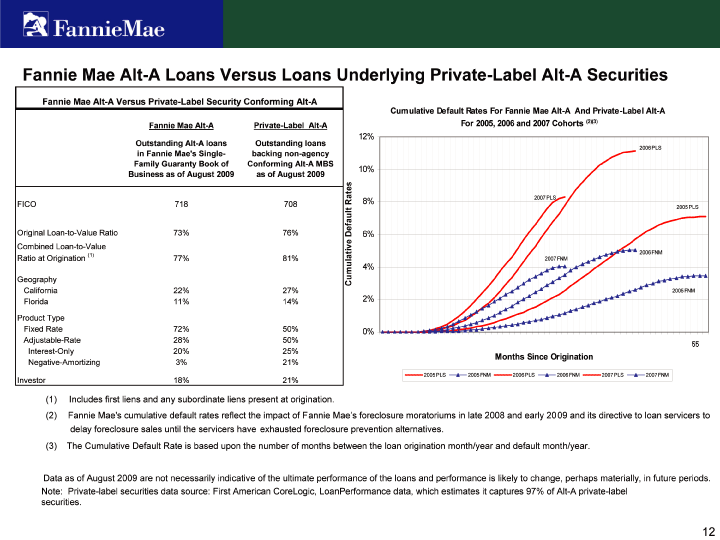
| Fannie Mae Alt-A Loans Versus Loans Underlying Private-Label Alt-A Securities Fannie Mae Alt-A Versus Private-Label Security Conforming Alt-A Cumulative Default Rates For Fannie Mae Alt-A And Private-Label Alt-A Fannie Mae Alt-A Private-Label Alt-A For 2005, 2006 and 2007 Cohorts (2)(3) 12% Outstanding Alt-A loans Outstanding loans 2006 PLS in Fannie Mae’s Single- backing non-agency Family Guaranty Book of Conforming Alt-A MBS 10% Business as of August 2009 as of August 2009 Rates 8% 2007 PLS FICO 718 708 2005 PLS Default Original Loan-to-Value Ratio 73% 76% 6% Combined Loan-to-Value Cumulative 2006 FNM Ratio at Origination (1) 77% 81% 2007 FNM 4% Geography California 22% 27% 2005 FNM Florida 11% 14% 2% Product Type Fixed Rate 72% 50% 0% Adjustable-Rate 28% 50% Interest-Only 20% 25% Months Since Origination Negative-Amortizing 3% 21% 2005PLS 2005 FNM 2006 PLS 2006FNM 2007 PLS 2007 FNM Investor 18% 21% (1) Includes first liens and any subordinate liens present at origination. (2) Fannie Mae’s cumulative default rates reflect the impact of Fannie Mae’s foreclosure moratoriums in late 2008 and early 2009 and its directive to loan servicers to delay foreclosure sales until the servicers have exhausted foreclosure prevention alternatives. (3) The Cumulative Default Rate is based upon the number of months between the loan origination month/year and default month/year. Data as of August 2009 are not necessarily indicative of the ultimate performance of the loans and performance is likely to change, perhaps materially, in future periods. Note: Private-label securities data source: First American CoreLogic, LoanPerformance data, which estimates it captures 97% of Alt-A private-label securities. |
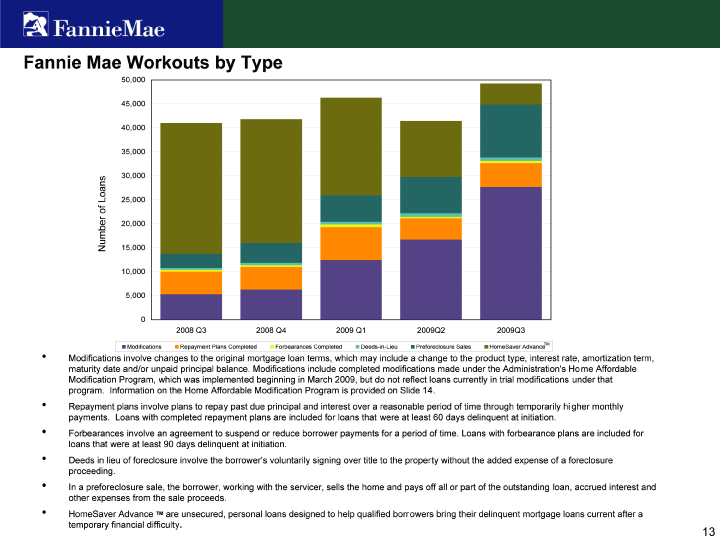
| Fannie Mae Workouts by Type 50,000 45,000 40,000 35,000 30,000 of Loans 25,000 Number 20,000 15,000 10,000 5,000 0 2008 Q3 2008 Q4 2009 Q1 2009Q2 2009Q3 Modifications Repayment Plans Completed Forbearances Completed Deeds-in-Lieu Preforeclosure Sales HomeSaver AdvanceTM • Modifications involve changes to the original mortgage loan terms, which may include a change to the product type, interest rate, amortization term, maturity date and/or unpaid principal balance. Modifications include completed modifications made under the Administration’s Home Affordable Modification Program, which was implemented beginning in March 2009, but do not reflect loans currently in trial modifications under that program. Information on the Home Affordable Modification Program is provided on Slide 14. • Repayment plans involve plans to repay past due principal and interest over a reasonable period of time through temporarily higher monthly payments. Loans with completed repayment plans are included for loans that were at least 60 days delinquent at initiation. • Forbearances involve an agreement to suspend or reduce borrower payments for a period of time. Loans with forbearance plans are included for loans that were at least 90 days delinquent at initiation. • Deeds in lieu of foreclosure involve the borrower’s voluntarily signing over title to the property without the added expense of a foreclosure proceeding. • In a preforeclosure sale, the borrower, working with the servicer, sells the home and pays off all or part of the outstanding loan, accrued interest and other expenses from the sale proceeds. • HomeSaver Advance TM are unsecured, personal loans designed to help qualified borrowers bring their delinquent mortgage loans current after a temporary financial difficulty. |

| Home Affordable Modification Program (HAMP) Details first announced in March 2009. Applies to loans owned or guaranteed by Fannie Mae or Freddie Mac, and non-agency loans meeting the HAMP eligibility requirements. Aimed at helping borrowers either currently delinquent or at imminent risk of default. Borrowers who are at risk of foreclosure must be evaluated for eligibility under the HAMP before any other workout alternatives are considered. Borrowers must satisfy the terms of a trial modification plan for a trial period of at least three months before a modification under the program becomes effective. Treasury has granted certain trial period extensions. For more information, refer to Fannie Mae’s 2009 Q3 Form 10-Q. As of September 30, 2009, approximately 189,000 Fannie Mae loans were in a trial period or a completed modification under the Home Affordable Modification Program, as reported by servicers to the system of record for the Home Affordable Modification Program. |

| Fannie Mae Modifications of Single-Family Delinquent Loans Change in Monthly Principal and Interest Payment of Modified Single Family Loans(1)(2) Re-performance Rates of Modified Single Family Loans(1)(3) 100% 90% % Current and 80% Performing Q2 2008 Q3 2008 Q4 2008 Q1 2009 Q2 2009 70% 3 Months post 60% modification 48% 45% 55% 62% 63% 50% 40% 6 months post modification 33% 35% 41% 46% n/a 30% 20% 9 months post modification 29% 28% 32% n/a n/a 10% 0% Q108 Q208 Q308 Q408 Q109 Q209 Q3 2009 Decrease greater than 20% of Principal and Interest Payment Decrease of less than or equal to 20% in Principal and Interest Payment No Change in Principal and Interest Increase in Principal and Interest Payment (1) Excludes loans that were classified as subprime adjustable rate mortgages that were modified into fixed rate mortgages and were current at the time of modification. Modifications include completed modifications made under the Administration’s Home Affordable Modification Program, which was implemented beginning in March 2009, but do not reflect loans currently in trial modifications under that program. Information on the Home Affordable Modification Program is provided on Slide 14. (2) Represents the change in the monthly principal and interest payment at the effective date of the modification. The monthly principal and interest payment on modified loans may vary, and may increase, during the remaining life of the loan. (3) Includes loans that paid off. |
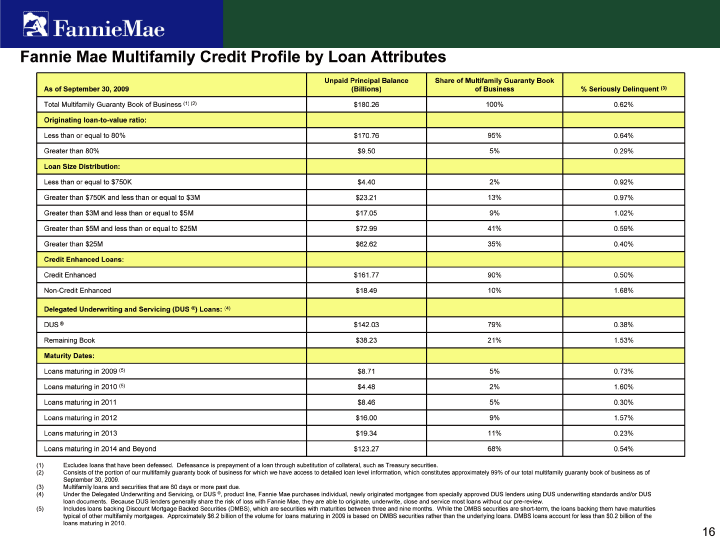
| Fannie Mae Multifamily Credit Profile by Loan Attributes Unpaid Principal Balance Share of Multifamily Guaranty Book As of September 30, 2009 (Billions) of Business % Seriously Delinquent (3) Total Multifamily Guaranty Book of Business (1) (2) $180.26 100% 0.62% Originating loan-to-value ratio: Less than or equal to 80% $170.76 95% 0.64% Greater than 80% $9.50 5% 0.29% Loan Size Distribution: Less than or equal to $750K $4.40 2% 0.92% Greater than $750K and less than or equal to $3M $23.21 13% 0.97% Greater than $3M and less than or equal to $5M $17.05 9% 1.02% Greater than $5M and less than or equal to $25M $72.99 41% 0.59% Greater than $25M $62.62 35% 0.40% Credit Enhanced Loans: Credit Enhanced $161.77 90% 0.50% Non-Credit Enhanced $18.49 10% 1.68% Delegated Underwriting and Servicing (DUS ®) Loans: (4) DUS ® $142.03 79% 0.38% Remaining Book $38.23 21% 1.53% Maturity Dates: Loans maturing in 2009 (5) $8.71 5% 0.73% Loans maturing in 2010 (5) $4.48 2% 1.60% Loans maturing in 2011 $8.46 5% 0.30% Loans maturing in 2012 $16.00 9% 1.57% Loans maturing in 2013 $19.34 11% 0.23% Loans maturing in 2014 and Beyond $123.27 68% 0.54% (1 ) Excludes loans that have been defeased. Defeasance is prepayment of a loan through substitution of collateral, such as Treasury securities. (2 ) Consists of the portion of our multifamily guaranty book of business for which we have access to detailed loan level information, which constitutes approximately 99% of our total multifamily guaranty book of business as of September 30, 2009. (3 ) Multifamily loans and securities that are 60 days or more past due. (4 ) Under the Delegated Underwriting and Servicing, or DUS ®, product line, Fannie Mae purchases individual, newly originated mortgages from specially approved DUS lenders using DUS underwriting standards and/or DUS loan documents. Because DUS lenders generally share the risk of loss with Fannie Mae, they are able to originate, underwrite, close and service most loans without our pre-review. (5 ) Includes loans backing Discount Mortgage Backed Securities (DMBS), which are securities with maturities between three and nine months. While the DMBS securities are short-term, the loans backing them have maturities typical of other multifamily mortgages. Approximately $6.2 billion of the volume for loans maturing in 2009 is based on DMBS securities rather than the underlying loans. DMBS loans account for less than $0.2 billion of the loans maturing in 2010. |

| Fannie Mae Multifamily Credit Profile by Acquisition Year MF Serious Delinquency Rates (SDQ) by Acquisition Year Cumulative Default Rates by Acquisition Year 0.40% 0.35% 1.40% Rate 0.30% 1.20% 2007 Default 0.25% 2005 1.00% 2006 Rate 0.20% 2007 0.80% Cumulative 0.15% SDQ 0.60% 2008 0.10% 0.40% 2006 2008 0.20% 2009 2005 0.05% 0.00% 0.00% Year Year Year Year Year Year Year Year Year Year 1 2 3 4 5 1 2 3 4 5 2005 2006 2007 2008 2009 2005 2006 2007 2008 Unpaid Principal Balance Share of Multifamily As of September 30, 2009 (Billions) Guaranty Book of Business % Seriously Delinquent (3) Total Multifamily Guaranty Book of Business (1) (2) $180.26 100% 0.62% By Acquisition Year: 2009 (4) $15.69 9% 0.19% 2008 $34.41 19% 0.46% 2007 $44.31 25% 1.20% 2006 $19.77 11% 0.36% 2005 $18.18 10% 0.28% Prior to 2005 $47.91 26% 0.58% (1 ) Excludes loans that have been defeased. Defeasance is prepayment of a loan through substitution of collateral, such as Treasury securities. (2 ) Consists of the portion of our multifamily guaranty book of business for which we have access to detailed loan level information, which constitutes approximately 99% of our total multifamily guaranty book of business as of September 30, 2009. (3 ) Multifamily loans and securities that are 60 days or more past due. (4 ) Does not include loans backing Discount Mortgage Backed Securities (DMBS), which are securities with maturities between three and nine months. While the DMBS securities are short-term, the loans backing them have maturities typical of other multifamily mortgages. DMBS are accounted for in their original acquisition year. In the 2009 Second Quarter Credit Supplement, loans backing DMBS were included in the acquisition volume for 2009. |
